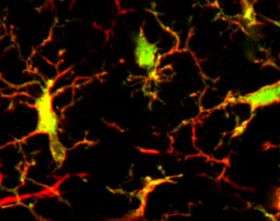First evidence of native dendritic cells in brain

In a finding that has the potential to change the way researchers think about the brain, scientists at Rockefeller University have found dendritic cells where they’ve never been seen before: among this organ’s neurons and connective cells.
The immunity-directing dendritic cell had previously been seen in the human nervous system only after brain injury or disease. But the new study, published next month in the Journal of Comparative Neurology, shows for the first time that the brain has its own, resident population of dendritic cells that may serve as a line of defense against pathogens that sneak past the blood-brain barrier.
The brain is packed with different types of microglia — cells that perform a variety of immune functions in the central nervous system. Until now, however, no one had identified dendritic cells among them. Research associate professor Karen Bulloch and her colleagues made their discovery using mice bred to have a fluorescent marker attached to a dendritic-cell specific protein.
Originally developed by Rockefeller scientists to help them visualize dendritic cells in immune tissues, Bulloch reasoned that the mice might be helpful in determining whether dendritic cells are also in the central nervous system. Bulloch, who’s spent a lot of time studying microglia, knew exactly where in the brain to look. But what she saw when she first peered through the microscope surprised her so much, she says, “I literally almost fell off my chair.”
Once they had confirmed that the brain seems to develop its own population of dendritic cells, the researchers, with the help of graduate student Melinda Miller, mapped the cells’ locations. “They ended up in places I just didn’t understand,” Bulloch says. So she did a bit of digging and discovered that the protective dendritic cells appeared in areas of the brain associated with postnatal neuron formation, as well as along nasal-associated pathways through which viruses, bacteria and toxic chemicals can gain direct access to the brain. “The dendritic cells serve both as shepherds of newborn nerve cells and as gatekeepers, which police intruding molecules that may come into the brain through these pathways.”
The discovery that some dendritic cells that are native to the brain, rather than just infiltrating during traumatic events, comes with a wide range of implications. “Their location suggests a multiplicity of functions, ranging from surveillance to participation in a number of events in the brain,” says Bruce McEwen, Alfred E. Mirsky Professor and head of the Harold and Margaret Milliken Hatch Laboratory of Neuroendocrinology, where the work was conducted. But their position might also be an important factor to consider when evaluating drug administration, since certain vaccines and medications are now given nasally.
“In a way, it’s reassuring that there are cells there monitoring for invaders. On the other hand, it raises questions about the wisdom of that vaccine approach in the first place. The degree to which these drug molecules might alter the immune system of the brain is unknown,” McEwen says.
Citation: The Journal of Comparative Neurology 508(5): 687-710 (June 10, 2008)
Source: Rockefeller University



















